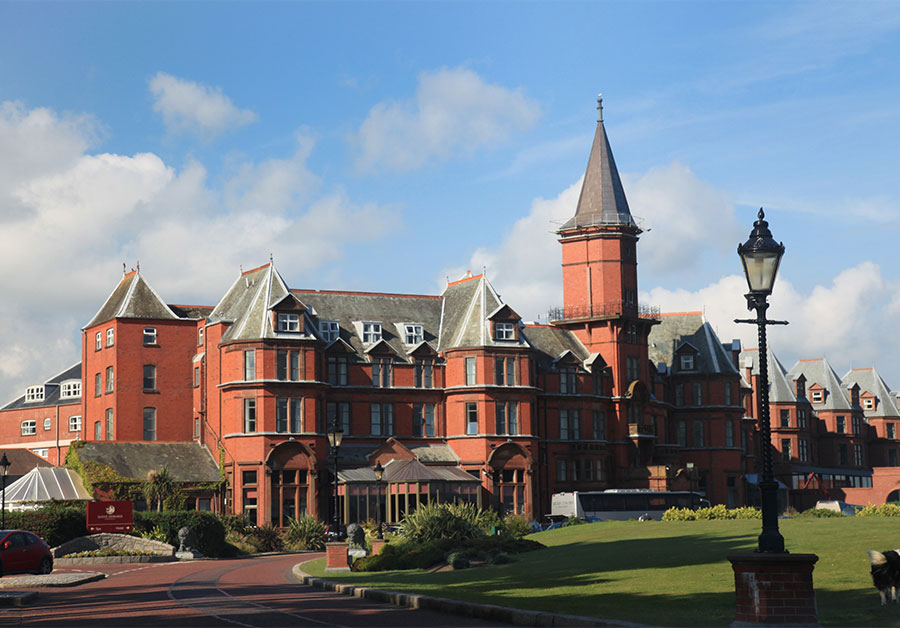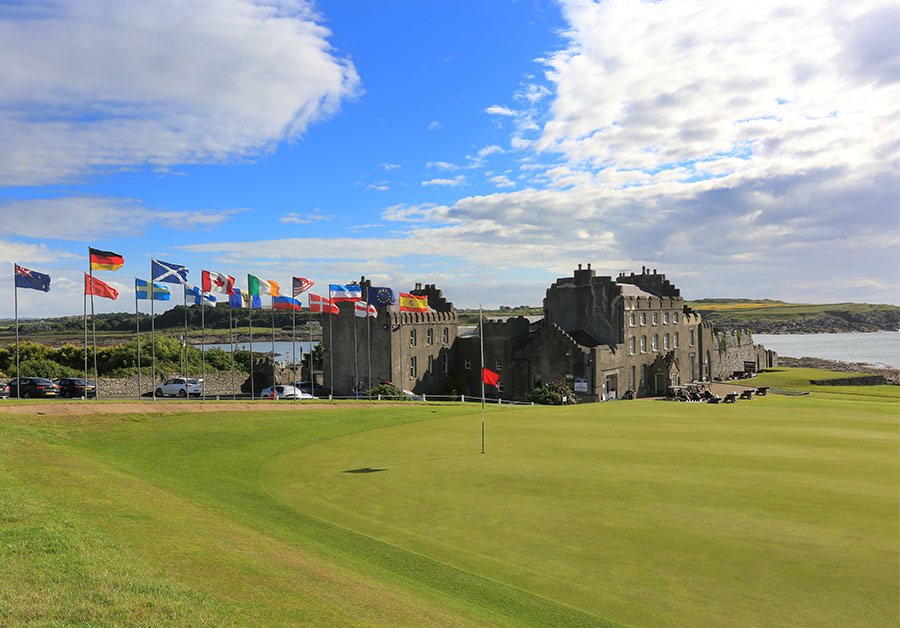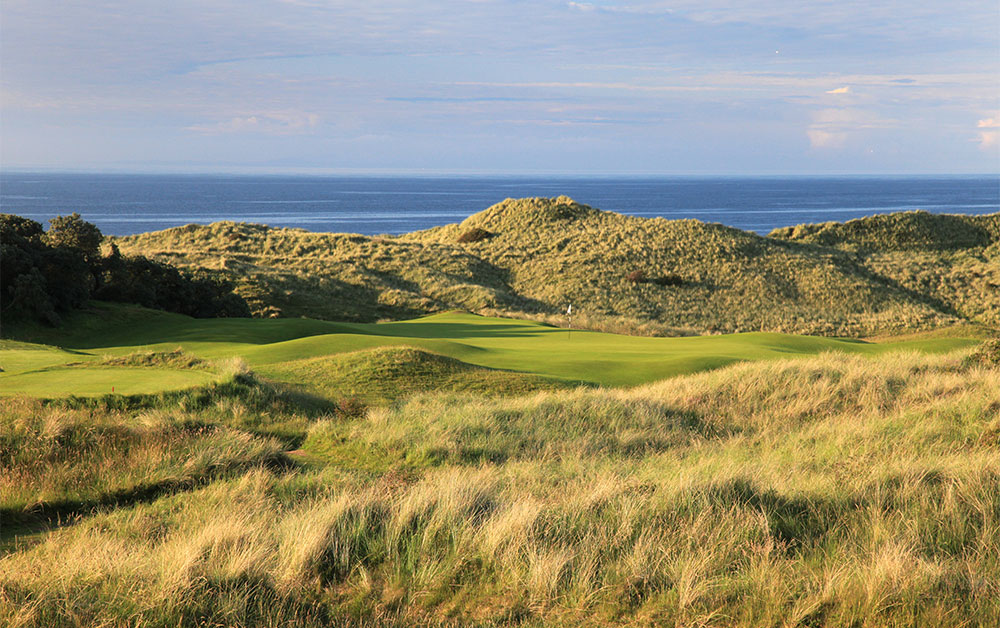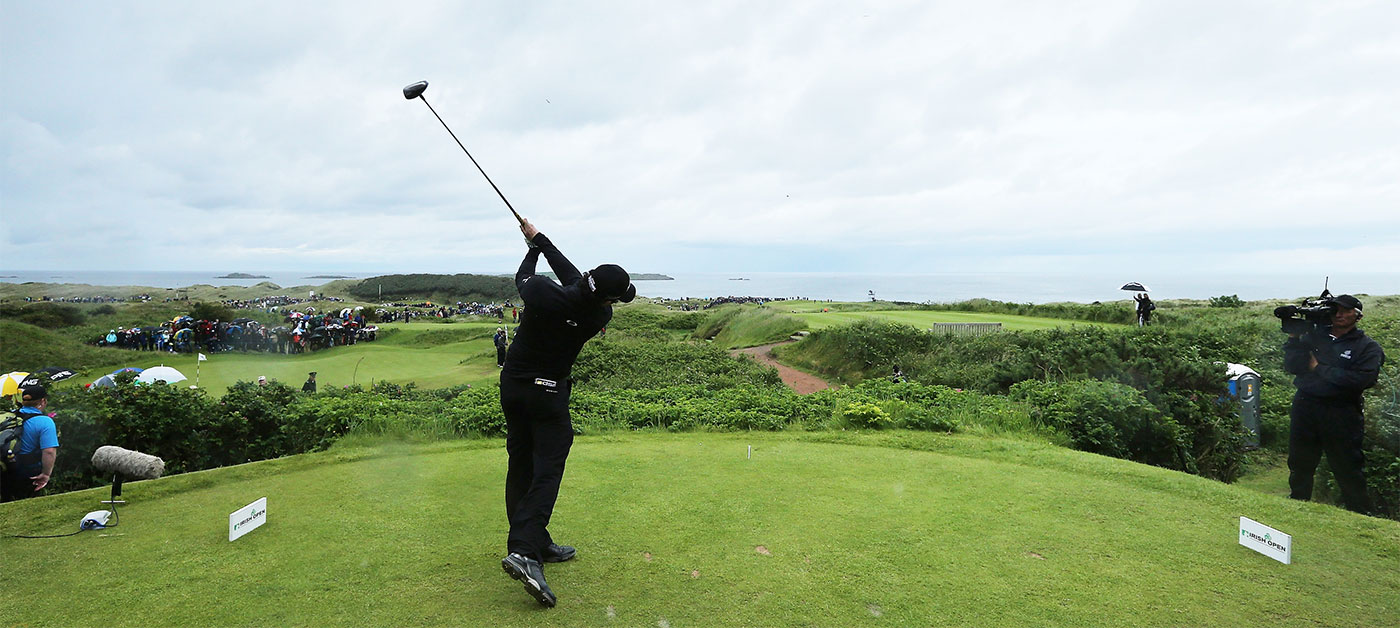Whatever your definition of commitment is, forget it.
To understand the full extent of dedicating oneself to a cause you needn’t look further than the group of modern-day Vikings who caused quite the scene a few years ago enroute to Royal Portrush. The gentlemen, reportedly malted up to their eyeballs after sampling their way around some of Scotland’s finest whisky distilleries, had an afternoon tee-time at the host course of this month’s 148th Open Championship and needed to get moving across the Irish sea. After missing their local ferry service, they decided to charter a motorised inflatable boat (it must have seemed like a splendid idea at the time!). All was going swimmingly for this devilish group of weekend warriors as the coast of Northern Ireland slowly appeared in full view on the horizon. But just as they started to limber up for the round of a lifetime, disaster struck. Their blow-up dingy struck a rock… and started to sink. Mayday calls triggered an all-out sea rescue and a helicopter was called in to winch the men from certain death. While the details on what immediately followed remain sketchy, the end result of this foolish tale is the stuff of legend, as told over and over again by local caddies.
“They still made their tee-time!” laughs my bagman on the first tee at Portrush in May.

While my journey to this nation lacked the desperation and drama of these drunken sailors, it nonetheless was just as long and, perhaps, even more rewarding by the end.
There’s an old Irish saying: “There are only two kinds of people, the Irish and those who wish they were.”
I’d been wishing for this golf pilgrimage from the day I first picked up a club – a cut-down mashie my father found from God knows where. After 24 hours in the air, I’d finally made it to the Land of Saints and Scholars.
As I disembarked the aircraft I saw a sign at Dublin Airport that read: Céad míle fáilte! (a hundred thousand welcomes). My mission in this faraway land, apart from not losing a hundred thousand golf balls, was to play this year’s host course of The Open – a little preview, if you like, of what was in stall for the world’s best players later this month. But before all that, I was in for a little treat… an extra special tee-time at the No.1 course on the planet. After a trademark Irish feast that included potato three ways, I needed a good night’s rest.

Day 1: A Royal welcome at County Down
Waking up to the warm open fires of the Slieve Donard Resort and Spa in Newcastle – my first port of call and home for the first two nights of my getaway – were comforting and confronting all at once. As I peered through the window of this famous hotel I could barely make out the entrance to Royal County Down Golf Club just metres away. The rain was coming in sideways, with volume, but I was assured the Irish sun – much like Melbourne’s – would make an appearance before we teed off.
After a few hours’ delay (yes, the rain did keep falling… all day!) we walked over to the first tee of the course ranked No.1 in the world by Golf Digest.
Old Tom Morris is credited for the original holes on the Championship Links here that opened for play in 1889. But understandably, several course designers have had their hand on this hallowed course over the past hundred years or so. Most notably, Harry Colt introduced improvements in 1925 including the fourth and ninth holes – possibly the most photographed ones on the course to date.
 Set with the Mourne Mountains in the background and hugged by the green landscape of the Murlough Nature Reserve, Royal County Down is as natural a layout as you will find. With Dundrum Bay on your right as you tee off on the 539-yard, par-5 starting hole, you will go on an outward-inward journey that will take you up and down gentle hillocks, zigzag through strategically angled fairways, and take on fast, domed greens. Along the way, the feathered bunkers rimmed by marram, red fescue and heather are as much eye-catching features as they are ball swallowing ones. The narrowest ribbons of fairways are surrounded by golden gorse: so beautiful to look at but so punishing for any who may stray from the prescribed path.
Set with the Mourne Mountains in the background and hugged by the green landscape of the Murlough Nature Reserve, Royal County Down is as natural a layout as you will find. With Dundrum Bay on your right as you tee off on the 539-yard, par-5 starting hole, you will go on an outward-inward journey that will take you up and down gentle hillocks, zigzag through strategically angled fairways, and take on fast, domed greens. Along the way, the feathered bunkers rimmed by marram, red fescue and heather are as much eye-catching features as they are ball swallowing ones. The narrowest ribbons of fairways are surrounded by golden gorse: so beautiful to look at but so punishing for any who may stray from the prescribed path.
Thinking your way around the course is probably the most important skill you need to play well here – and you’ll need a caddie. Plotting your way from tee to green doesn’t necessarily mean you take the most obvious line, and knowing where the hazards are, and which part of the fairway to put your shots can mean a world of difference. The lovely par-4 ninth is a good example. At 486 yards long, this is no slouch by any means, and way too long for many to get on in regulation. The fairway is angled, and the green is tucked at the end of a chute, protected by two deep bunkers. For the distance-challenged, playing it as a par 5, and enjoying the views from the tee perched some 60 feet above, is probably the way to go.
Inclement weather aside, there was something so incredibly joyous and surreal about navigating my way around this place, soggy cleats and all. To think many esteemed judges put this place above Pine Valley, Augusta National, Cypress Point and Royal Melbourne is a reaffirmation that old is forever great, regardless of all that time and technology thrown at it.
“If I truly had a single-destination global golf pass I’d do what I did recently: I’d travel to Northern Ireland and lose myself on the course that native players call Newcastle and the rest of us know as Royal County Down,” says globetrotting Golf Digest contributor David Owen.
“The standard complaint about Royal County Down is that the second nine doesn’t measure up to the first, and the standard response is, Well, what could?”
I’m racking my brains…
Another telltale sign of Royal County Down’s popularity? The 12-month waiting list just for a tee-time. Yep, plan ahead, Australia!
If you are lucky enough to land yourself a start, you’ll notice two fascinating features to this place. The first is the club’s second course, called the Annesley, which intersects the championship course but is nearly 2,500 yards shorter. You may pass it on your way to the driving range.
The second feature is the clubhouse of Mourne Golf Club that you’ll see on your right during the walk over from the Slieve Donard. Mourne was established in the 1940s for residents of Newcastle, who are generally considered, by the main club’s members, to be less clubable than their Belfast brethren; it has its own, relatively modest clubhouse and 350 members who can play the Annesley course whenever they like and the Championship course on any day but Saturday – and all for a little more than £800 a year. “It’s the best golf deal in the world,” says Shaun Killough, past captain of Mourne Golf Club.
Back to the Slieve Donard and it’s definitely worth staying at this regal, grand hotel if you’ve planned a round at Royal County Down. Indeed the finely appointed rooms and spa make it a destination by itself. But the charming Newcastle township is but a five-minute walk from the hotel and it’s worth a stroll through with its quaint shops, cafés and restaurants. Coffee lovers are advised to check out the Railway St Café & Brew Bar, while a few doors down Brunel’s Restaurant will slap you in the face with its bold and creative gourmet cuisine and cocktail menu.
But with Slieve Donard’s top-notch ESPA spa, the elegant Chaplin’s Bar, three restaurants of varying character (Oak Restaurant for fine dining, Lighthouse Lounge for a healthy lunch, or Percy French Inn for a view) and the beach right at its doorstep, there is every reason not to leave the resort’s premises – other than to play golf, of course.

Day 2: Going way back in time
The shirt hanging up in the pro shop said it all: “Ardglass… Drinking Village With a Golfing Problem.”
Thirty minutes down the road from Royal County Down, via the historic village of Downpatrick, we arrived at one of the most otherworldly courses you will ever see. If the opening stretch of holes at Ardglass Golf Club aren’t the most spectacular you’ve played, the clubhouse you start your 18-hole adventure from is definitely the oldest and coolest you’ve set foot in.
 Built in 1405 – yes, FOURTEEN-OH-FIVE – Ardglass’ 19th hole is an old castle riddled with ancient artefacts and original fittings. Formally a fortified warehouse that operated as a safe haven for 15th century importers and exporters, the building is now where locals gather for a pint and to solve the world’s problems.
Built in 1405 – yes, FOURTEEN-OH-FIVE – Ardglass’ 19th hole is an old castle riddled with ancient artefacts and original fittings. Formally a fortified warehouse that operated as a safe haven for 15th century importers and exporters, the building is now where locals gather for a pint and to solve the world’s problems.
Outside, the history lessons continue. The opening hole, complete with a tee that our man Owen describes as an extension of either the castle or the Irish Sea – is worth a trip by itself. It’s not much more than 300 yards from the back tee, but you have to pound one over a dramatic rocky shoreline up to where a life preserver hangs ominously from a stone wall at the 75-yard mark. The green complex here sets the scene for what’s to come – small, funky putting surfaces that are as original as the day they were first carved out of the jagged landscape.
But people who have played here don’t dare share their story without mentioning the clifftop par-3 second, where the tee is separated from the green by a bottomless chasm. Those familiar with Hogan’s Hole at Narooma on the New South Wales South Coast will appreciate the challenge here. Carry the gap, let alone hit the green, and you’ve earnt the right to shout yourself the best Guinness we tasted all week, right upstairs on the club’s castle terrace.
Ardglass simply hugs the coastline, with no fewer than eight holes bringing the Irish Sea into play. When I asked the head pro for his advice on how to best tackle the course, he was short and sharp with his reply. “Don’t go left.” Hard advice to follow when you spend the entire front nine gazing at the ocean by your side. In fact, water is visible from all 18 tees and greens. “On a clear day it’s even possible to see the Isle of Man,” says the club’s director of golf, Paul Vaughan.

While the views are incredible, it’s the authenticity of this place that hooks you from the word go. From the exposed rock and ancient artefacts littering the fairways, to having to duck (a lot!) when walking into the clubhouse bathrooms, you’ll feel like you’ve walked onto a medieval movie set. One can even imagine the course itself once being a battleground, perhaps for local fisherman protecting their catch, only these days the enemy come brandishing bags full of titanium and urethane.
In short, Ardglass is a beauty by the sea. Even if you don’t successfully navigate the drama and elements from tee to green, you’re guaranteed to have a lot of fun trying.
After several pints of Guinness reflecting the day just gone, it was time to head to the Causeway Coast in preparation for our much-anticipated round at Royal Portrush.
We were booked in for dinner at the Bushmills Inn Hotel, a quaint little pub right in the middle of the Causeway Coast and just minutes from the iconic Giants Causeway landmark. Famous for its feeds and true Irish hospitality, the place didn’t disappoint.
There are some truly amazing gastronomic highlights to be had in this part of the world, but the Guinness and onion soup at Bushmills has to be the country’s greatest culinary accomplishment since Joseph “Spud” Murphy gave us flavoured potato chips. A few more ‘nightcaps’ and it was time to head to our accommodation – the Causeway Hotel located on the stunning UNESCO World Heritage site at Giant’s Causeway. With 28 stylish rooms boasting stunning views of the Atlantic Ocean, this place is great as it guarantees easy access – and free onsite parking – into Northern Ireland’s top visitor attraction.
But it was getting late and we all had Portrush on our mind, so it was time to shut our eyes.

Day 3: What it’s really like to play Royal Portrush
Unexpectedly, my round at this year’s Open Championship venue started on a rather sombre note. A couple of holes in, one of the group’s caddies broke the news that he had only two weeks to live.
“Oh, God, I’m so sorry to hear that,” one of my playing partners replied, not wanting to pry any further.
Thankfully, he didn’t have to.
“Yeah… I’m getting killed by a dragon.”
 Turns out this limerick-laden looper was an extra in the worldwide smash-hit TV series “Game Of Thrones”, and his character was about to meet a very unfortunate end at the claws of some mystical creature. Arguably the most popular TV drama of all time, we should have known such a coincidence was bound to happen in a region where countless scenes were shot.
Turns out this limerick-laden looper was an extra in the worldwide smash-hit TV series “Game Of Thrones”, and his character was about to meet a very unfortunate end at the claws of some mystical creature. Arguably the most popular TV drama of all time, we should have known such a coincidence was bound to happen in a region where countless scenes were shot.
As we continued our breathtaking walk, our TV-star caddie pointed out parts of the course where GoT was filmed. When we reached the fourth hole, a beautiful, long par 4 along the boundary of the course highlighted by a partially hidden green tucked behind a dune, I pointed out a beautiful big home next to the fairway that had the most impressive manicured lawn.
“If I owned that place, that’s where I’m watching this year’s Open,” I said to the group.
“Funny you mention that,” said our looper, “The owner was apparently offered $100,000 for the week to rent out his backyard for, you know, a corporate marquee or grandstand space. He knocked it back!” As they say, location, location, location….
So what about the course itself? Does it stack up to its billing as a worthy Open host? Absolutely. Apart from boasting some of the best putting surfaces in the world, it has some of the best short risk/reward holes and brilliant par 3s.
The reworked layout, which now sees the infamous par-3 14th “Calamity” hole played as No.16, sets up one of the best finishes in Major championship golf with 17 and 18.
Trust me, I know. Standing on the 16th tee at five-over, and only then thanks to four earlier birdies, I found out where this hole derived its name from, pushing one right and watching it roll down into oblivion. I somehow found it down a grassy canyon, escaped with a bogey, before recollecting my thoughts on the 17th tee.
“Don’t get too relaxed, lad” said our caddie. “They call this hole Purgatory.”
I sighed… and found the junk yet again off the tee, rescuing another bogey before I flushed one down 18. “That’s more like it.”
As I approached my drive for the final time, the gigantic 10,000-seat grandstand erected around the green came into full view. I momentarily lapsed into a dream. I was about to close out the 2019 Open Championship with one last act of brilliance. I stood over my ball, peeked up at the pin, and went whack!
It was then I looked up and watched my ball snap-hook into the very top tier of the stands, snapping me out of my dream in the process. I took my relief and closed with yet another wasted opportunity. But, boy, it was fun. It may just be the most memorable 80 I’ll ever shoot. Alas, no Auld Claret Jug for me but if the wind blows this month, our caddie predicts plenty of big scores like mine.
“I reckon about 14-under will win it, but if the weather turns sour, who knows?” he said.
One thing I do know, however, is it will be a lot fun to watch … just as golf should be.

Rory: Why my Northern Ireland is so special
There are many people we could have hit up for an opinion on what makes Northern Ireland stand out from the crowd. But as far as local products go, to those who are really in the know, Rory McIlroy is king.
Born and bred in Holywood, County Down, McIlroy spent his entire childhood mastering his game in this part of the world. His home club, Holywood Golf Club, has the “Rory Room” – a shrine dedicated to their hero member that’s packed with Rory memorabilia from floor to ceiling.
In a strange kind of way, it could be why this country is still understated in some parts as a world-class golf destination. Its people prefer to boast about their world-class talent instead of their world-class greens.

“There’s definitely not a big fuss made about it,” McIlroy tells Australian Golf Digest. “I think it’s the same in Scotland and England… there’s no fanfare made about playing these great courses. Whereas in places like America, it’s a bit of a production.
“In Northern Ireland it’s pure golf. There’s nothing else. It’s going out
there and braving the course, conditions and elements. It’s the way the game is meant to be played.
“I guess you could say it’s getting back to the essence of what golf truly is.”
The other beauty of golf in Northern Ireland, of course, is the access to arguably the greatest collection of links courses in such close proximity.
“Courses like Royal County Down should always remain accessible to the public – that’s the beauty of our sport,” McIlroy says. “It doesn’t matter if you have 10 zeros at the end of your bank account or one zero, you have an opportunity to go out and play the game. Whether it’s on a public course or a private course, I’m all for making the game more accessible. The more accessible we can make some of the greater golf courses in the world, the better.”
But it’s not all about golf, says McIlroy. Northern Ireland’s array of off-course activities doesn’t always get the attention it deserves.
“Everyone knows about Northern Irish hospitality but there’s so much to see and do, particularly at this year’s Open venue Portrush. There’s the Giants Causeway and the Carrick-a-Rede Rope Bridge. There’s so much history and culture to see. But again, if you’re there to have a quintessential golf trip, there are plenty of great courses – and bars – to visit.”
Like Rory, we’ll be back to sample more, too.
– Interviewed by Evin Priest
 How We Got There
How We Got There
The one knock for Australians travelling to places like Ireland and the United Kingdom is the logistical marathon to get there. Generally a flight to London, broken up in the middle with a stopover, isn’t complete without a third leg to your final destination. Qatar Airways has solved that headache with direct flights into Dublin via Doha from several Australian capital cities.
The airline, which connects passengers to 160 destinations worldwide, flies twice daily out of Sydney and once daily out of Melbourne, Perth, Adelaide and Canberra.
“One of the many great benefits you get flying with Qatar Airways is we are a partner of the Oneworld Alliance reward program, meaning you can benefit from your existing frequent flyer program that includes Qantas,” says Qatar Airways’ regional manager direct sales in Australasia, Ken Lau.
Like us, you’re bound to be impressed with the five-star Hamad International Airport in Doha as you make your connecting flight into Dublin stress-free.
See qatarairways.com for more
Key Contacts
PLAY
Royal County Down Golf Club
36 Golf Links Road, Newcastle
County Down BT33 0AN
T: +44 (0) 28 4372 3314
W: royalcountydown.org
Ardglass Golf Club
Castle Place, Ardglass, Downpatrick
County Down BT30 7TP
T: +44 (0) 28 4484 1219
W: ardglassgolfclub.com
Royal Portrush Golf Club
Dunluce Road, Portrush
County Antrim BT56 8JQ
T: +44 (0) 28 7082 2311
W: royalportrushgolfclub.com
STAY
Slieve Donard Resort and Spa
Downs Road, Newcastle
County Down BT33 OAH
T: +44 (0) 28 4372 1066
W: hastingshotels.com/slieve-donard-resort-and-spa
Causeway Hotel
Giants Causeway, 40 Causeway Rd, Bushmills
County Antrim BT57 8SU
T: +44 (0) 28 2073 1210
W: thecausewayhotel.com
 EAT
EAT
Bushmills Inn
9 Dunluce Road, Bushmills,
County Antrim BT57 8QG
T: +44 (0) 28 2073 3000
W: bushmillsinn.com
[Guinness & onion soup pictured ]
Brunel’s Restaurant
32 Down’s Road, Newcastle
County Down BT33 0AG
T: +44 (0) 28 4372 3951
W: brunelsrestaurant.co.uk



